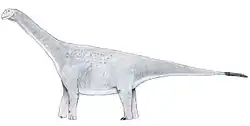| Anhuilong Temporal range: Middle Jurassic, | |
|---|---|
 | |
| Skeletal Diagram | |
| Scientific classification | |
| Domain: | Eukaryota |
| Kingdom: | Animalia |
| Phylum: | Chordata |
| Clade: | Dinosauria |
| Clade: | Saurischia |
| Clade: | †Sauropodomorpha |
| Clade: | †Sauropoda |
| Family: | †Mamenchisauridae |
| Genus: | †Anhuilong Ren et al., 2020 |
| Type species | |
| †Anhuilong diboensis Ren et al, 2020 | |
Anhuilong (meaning "Anhui dragon") is a genus of mamenchisaurid dinosaur known from the Hongqin Formation of Anhui province, China. The genus contains a single species, Anhuilong diboensis.[1]
Discovery and naming
Anhuilong is known from the holotype AGB 5822, a forelimb consisting of a left humerus, ulna, and radius. It is distinguished by the following combination of features: low ratios of the average of the greatest widths of the proximal end, mid-shaft and distal end of the humerus/length of the humerus, total length of ulna to humerus and total length of radius to humerus; the lateral edge of the deltopectoral crest directs caudolaterally, the lateral accessory condyle on the craniodistal edge of humerus is more robust than the medial one, and the cross-sectional shape of the ulna at mid-shaft is elliptical with highest ratio of transverse to craniocaudal diameter among mamenchisaurids.[1]
Phylogeny
Ren et al. (2020)[nb 1] recovered Anhuilong as the sister taxon of Huangshanlong, with the closest relative of this clade being Omeisaurus tianfuensis. The results of their phylogenetic analysis are shown in the cladogram below:[1]
| Eusauropoda |
| |||||||||||||||||||||||||||||||||||||||||||||||||||||||||||||||||||||||||||||||||||||||||||||||||||||||||
References
Notes
- ↑ Although the name first appeared online in 2018, it was only validly published in 2020.










